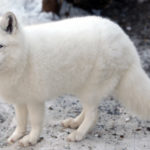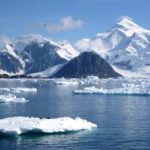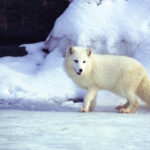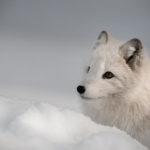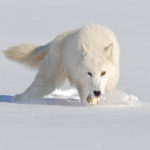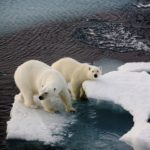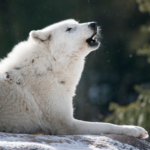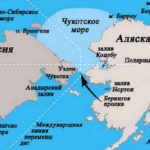Secrets of the Arctic Ocean
 Many scientific secrets and mysteries of the Arctic Ocean, worrying the best minds of past generations, remained a legacy of our era. One of them – climate fluctuations and the influence of the Arctic on the weather in temperate latitudes. It has long been noted that from time to time cold air masses from the Arctic spread southward. Some of these intrusions with the speed of the train reach the coast of the Black Sea and dramatically worsen the weather there.
Many scientific secrets and mysteries of the Arctic Ocean, worrying the best minds of past generations, remained a legacy of our era. One of them – climate fluctuations and the influence of the Arctic on the weather in temperate latitudes. It has long been noted that from time to time cold air masses from the Arctic spread southward. Some of these intrusions with the speed of the train reach the coast of the Black Sea and dramatically worsen the weather there.
In such periods, it is fair to say that in the Arctic Ocean is the “key to the weather” for a large part of our country. However, this “weather key” does not always work. There are also periods when the Arctic is experiencing powerful invasions of warmer air masses from the northern part of the Atlantic Ocean.
Meteorologists have surrounded the Arctic Ocean with a network of meteorological stations and conduct continuous observations of weather changes. Their task is to reveal the reasons due to which the Arctic becomes the “key of the weather” for temperate latitudes, then ceases to be, learn how to predict in advance the frequency and power of Arctic invasions on the continents.
Another mystery of the Arctic Ocean is the distribution of waters of various origins and changes in currents.
The works of our scientists have already allowed us to find out where and what waters lie, in what ways they are distributed. And now we need to find out at what speed they move and how the speed of currents can change in different years and seasons.
The third most important task is the disclosure of the laws of changing ice conditions in the Arctic seas. This is very important for navigation in the ice. Our scientists have created an interesting branch of science – the science of ice forecasts, which allows to calculate the ice situation in the seas in advance.
What a fascinating thing it is to watch the ice, its movement, growth and melting, rallying and rarefaction. Scientists make these observations in the Arctic from aboard a transport vessel, apprehensively approaching ice; from a special expeditionary vessel or icebreaker boldly invading the ice kingdom; from the coast of the mainland or a distant island, lost in the expanses of the sea. Recently, they are increasingly taking off in the air on an airplane and in a few hours examining huge parts of the seas.
Observations on the behavior of ice are also conducted in quiet cabinets, in which multi-colored maps lie on the desks with ice patterns painted on them. Information about it just brought wireless, connecting the office with the polar station, expedition, ship and aircraft. And the sense of pride in the success of our science is quite understandable, when scientists, having calculated the possible changes in ice, indicate the time of the ships leaving the track and the way they follow to bypass the heaviest accumulations of ice.
There are other scientific problems in the field of geography, geophysics and oceanology, on the solution of which scientists are working. Nowadays, the development of mining in the Northern region is becoming very relevant.
In recent years, many countries have gained interest in the Arctic. This is mainly due to the fact that huge reserves of oil and gas have been explored here. According to preliminary data, in the Arctic about 100 billion tons of oil and about 50 trillion tons are deposited. cubic meters of gas. This led to the fact that the oil-producing countries began to actively explore new and open fields. As a result, there was even a conflict between Russia and Norway about the zones of ownership. In 2010, Russia and Norway were forced to conclude an agreement on the division of borders in the waters of the Barents Sea, but the disputes still have not subsided.
In 2014, Gazprom has already begun oil production on the Arctic shelf. In 2014, almost 300 thousand tons of oil were produced, and in general, it is planned to expand oil production to 6 million tons per year by 2020. The issue of gas production in the Arctic is still open, but scientists from many countries are working on it. Now on the territory of the Arctic Ocean several expeditions are operating. Some of them are not exactly scientific. Most often, their task is to create conditions for the deployment of a military contingent capable of influencing the political situation in the Arctic. So American submarines are increasingly appearing in the North Pole area.
In response to these claims, Russia also does not stand still. Over the past couple of years, the presence of the Russian armed forces has begun to resume in the Arctic. For this, several old ones will be restarted and new bases will be built. Thus, the base on the Kotelny Island was completely reconstructed, where an almost new military town and an airfield were built, which had not functioned for 27 years, and Russian Air Force planes would be on duty around the clock.
The restoration of the Russian military base on the New Siberian Islands has begun, where the Russian Navy will be provided on a permanent basis. The military base and the Rogachevo airfield on Novaya Zemlya are being restored and reconstructed. The MiG-31 fighter jets will be placed here that will reliably cover the air northern borders of the Russian Federation. The use of the former nuclear test site in the south of the archipelago is being revised.
And although Russia intends to continue to restore the military infrastructure, develop and strengthen its position in the Arctic, it is also ready to take into account the interests of other states, Russian President Vladimir Putin said in August 2014.



